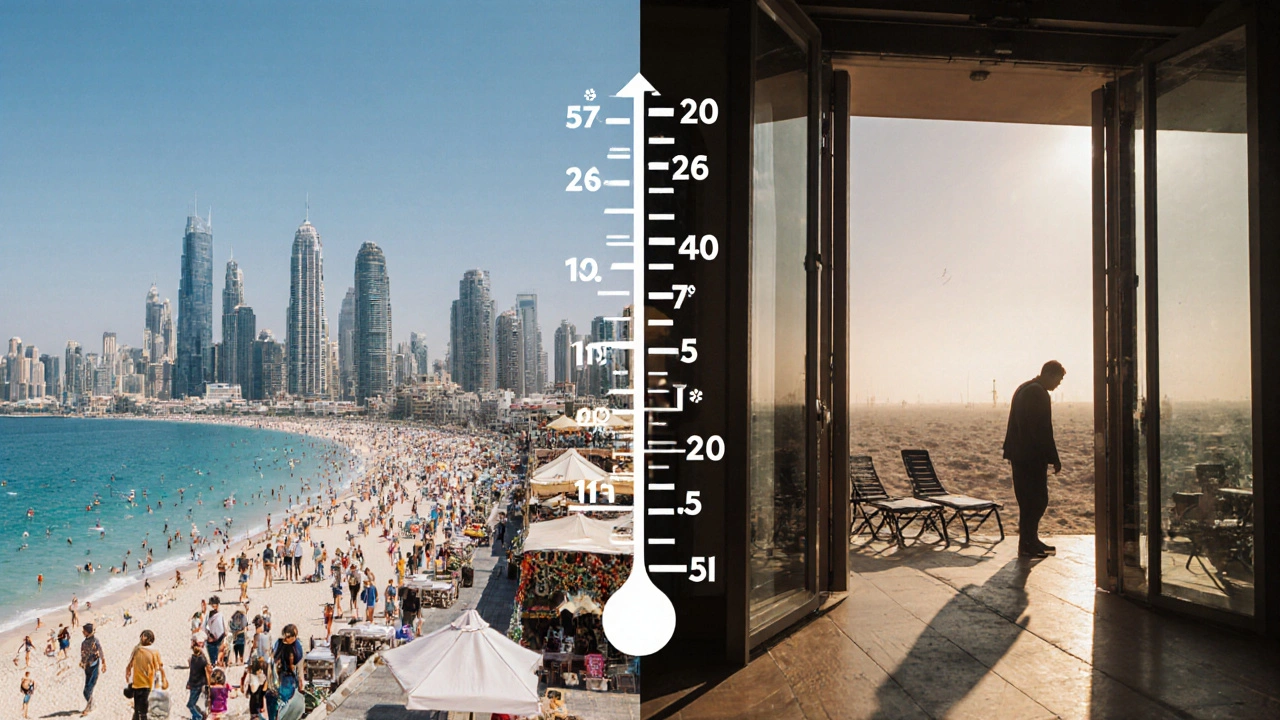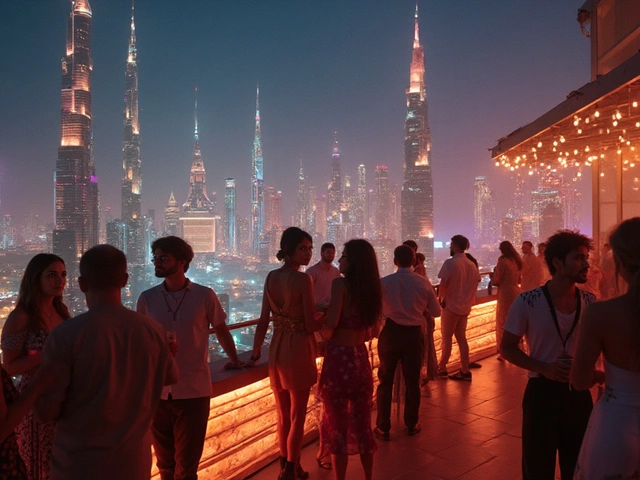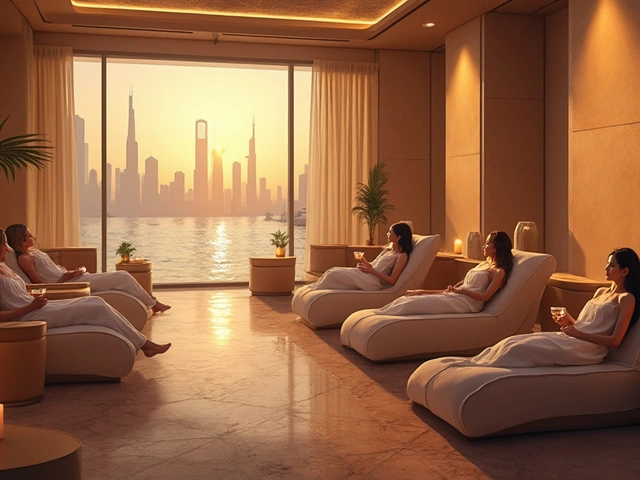You’ve got your flights booked, your passport ready, and your suitcase half-packed. But one question still hangs over you: when is the best time to visit Dubai? If you pick the wrong month, you could end up sweating through your sightseeing or paying triple for a hotel. The truth? Dubai isn’t just hot or cold-it’s a place that transforms completely with the seasons. And if you know when to show up, you’ll get the Dubai most travelers only dream about: cool breezes, golden sunsets, and crowds you can actually walk through.
Here’s the quick answer
The best time to visit Dubai is between November and March. During these months, temperatures hover between 20°C and 30°C (68°F-86°F), the sky stays clear, and the humidity drops to levels that actually feel comfortable. This is when the city truly comes alive-outdoor markets, desert safaris, rooftop bars, and beach lounging all become enjoyable again. Skip the summer if you can. April through October? It’s not just hot-it’s punishing.
Why timing matters more than you think
Dubai isn’t like Paris or Tokyo. You can’t just show up any day and expect to wander around comfortably. In July, the average high hits 41°C (106°F), and the humidity clings to you like a second skin. Air conditioning keeps indoor spaces bearable, but stepping outside for even five minutes feels like walking into a sauna. You’ll spend more time in your hotel than exploring. And don’t get me started on the desert. A 4x4 safari in 45°C heat? That’s not adventure-that’s endurance testing.
But here’s the flip side: winter in Dubai is magic. The air turns crisp in the evenings, the sky stays blue for weeks, and the city lights up in ways it doesn’t during the long, sweltering summer. You can actually enjoy the Burj Khalifa’s observation deck without feeling like you’re melting. You can walk along the Dubai Marina without needing a nap afterward. And yes-you can even ride a camel in the desert without sweating through your clothes.
What happens month by month
- November: The perfect transition. Days are warm but not scorching-around 28°C (82°F). The humidity fades fast. This is when locals start heading out again. Events like the Dubai Shopping Festival begin to pop up. Hotels are still reasonably priced.
- December: Peak season. Temperatures drop to a sweet spot-22°C to 26°C (72°F-79°F). The desert feels cool at night. Christmas lights go up across the city. Crowds grow, but so does the energy. Book early if you want a good deal on a luxury hotel.
- January: Arguably the best month. It’s cool, dry, and sunny. Perfect for outdoor activities. The Dubai International Film Festival and other major events run this month. It’s also when you’ll find the most international visitors-so expect lively restaurants and busy souks.
- February: Still great. Temperatures stay mild, and the air feels fresh. This is the last month before the heat starts creeping back. Great for photography, hiking in Hatta, or spending a day at Jumeirah Beach.
- March: The tail end of the sweet spot. Days are still pleasant, around 28°C (82°F), but humidity begins to rise. If you’re flexible, this is your last chance for low-season prices before April hits.
- April-October: Avoid if you can. April brings the first real heat. By June, it’s consistently above 40°C (104°F). July and August? Those are the worst. The sun doesn’t just shine-it dominates. Most expats leave during these months. Tourists? They stick to indoor malls and air-conditioned attractions.

What you can do in each season
If you visit between November and March, you’re not just escaping the heat-you’re unlocking experiences you can’t have the rest of the year.
- Desert safaris: The dunes are golden and soft underfoot. Sunset drives are breathtaking. You can even sit outside under the stars without needing a blanket.
- Beach days: Jumeirah Beach and Kite Beach are packed with people-but not because they’re forced to be there. They’re there because it’s enjoyable. The water is warm enough to swim without shivering.
- Outdoor dining: Rooftop restaurants like At.mosphere and The Address Downtown offer views you can actually appreciate. No one’s sweating through their shirt while trying to enjoy a cocktail.
- Shopping: Dubai Mall isn’t just a place to buy stuff-it’s an experience. In winter, you can walk from one end to the other without needing to stop for air conditioning breaks.
- Day trips: Hatta, Fujairah, and the Hajar Mountains become reachable. You can hike, swim in natural pools, and enjoy cool mountain air-all within an hour’s drive.
Now, if you’re stuck visiting in summer? Don’t panic. Dubai has mastered the art of indoor living. The Dubai Mall has an indoor aquarium, an ice rink, and a massive indoor theme park. The Mall of the Emirates has Ski Dubai. But here’s the truth: you’re paying more for less. You’re missing the soul of the city-the desert, the sea, the open-air souks. You’re not seeing Dubai. You’re seeing its air-conditioned shell.
Price differences you can’t ignore
Let’s talk money. In December and January, a five-star hotel room that costs $150 a night in October can jump to $500. Flights? Up 60-80%. If you’re budget-conscious, you’ll want to avoid peak season. But here’s the trick: the shoulder months-November and March-are where the real value is.
For example:
- November: Hotel prices are 30-40% lower than in January. Flights are still affordable. The weather? Almost perfect.
- March: You get 90% of the winter experience with 20-30% lower prices. The crowds are thinning, but the weather hasn’t turned yet.
And if you’re okay with heat? Late April and early October can be surprisingly good. The crowds are gone. Hotels are discounted. You just need to plan your days around the sun-mornings and evenings only.
What locals know that tourists don’t
Most visitors think Dubai is always about luxury and glitz. But locals? They know the real rhythm. In summer, they leave. They head to Oman, the Maldives, or even Europe. They come back in November, and suddenly, the city feels alive again. The food stalls outside the souks reopen. The beach clubs start playing live music. The desert tours fill up again.
So if you want to see Dubai the way it’s meant to be seen-not as a tourist trap, but as a living, breathing city-go when the locals do. November through March. That’s when the soul of Dubai returns.

Comparison: Dubai in Winter vs. Summer
| Factor | November-March (Winter) | April-October (Summer) |
|---|---|---|
| Average Temperature | 20°C-30°C (68°F-86°F) | 32°C-45°C (90°F-113°F) |
| Humidity | Low to moderate | Very high (70-90%) |
| Outdoor Activities | Desert safaris, beach days, hiking, rooftop dining | Limited to indoor malls and air-conditioned attractions |
| Tourist Crowds | High, but manageable | Low-many locals are away |
| Hotel Prices | High (peak in Dec/Jan) | Low to moderate (April, May, October) |
| Flight Costs | High | Up to 50% cheaper |
| Best For | First-time visitors, families, photographers, outdoor lovers | Budget travelers, digital nomads, indoor activity lovers |
Frequently Asked Questions
Is Dubai too hot to visit in July?
Yes, July is the worst month to visit if you’re not used to extreme heat. Average highs reach 41°C (106°F), and humidity makes it feel like 50°C (122°F). You can still visit, but you’ll spend most of your time indoors. If you do go, plan activities for early morning or late evening, and drink way more water than you think you need.
Can I swim in Dubai in winter?
Absolutely. The sea stays warm year-round, but in winter, it’s ideal-around 22°C to 25°C (72°F-77°F). No wetsuits needed. Jumeirah Beach and Kite Beach are perfect for swimming, paddleboarding, or just lying in the sun without overheating.
What’s the cheapest month to visit Dubai?
The cheapest months are April, May, September, and October. These are the shoulder months before and after peak season. Hotels drop by 40-60%, and flights are significantly cheaper. Just be ready for heat-especially in May and September, when temperatures start climbing.
Is Dubai busy during Christmas?
Yes, December is one of the busiest months. Christmas lights, New Year’s fireworks, and the Dubai Shopping Festival bring in huge crowds. If you want to avoid the rush, go in November instead. You’ll still get great weather and lower prices.
Do I need to book everything in advance?
If you’re visiting between November and March, yes. Popular attractions like Burj Khalifa, desert safaris, and dinner cruises sell out weeks ahead. Book at least 2-3 weeks in advance. In the summer, you can often walk in-because fewer people are around.
Final tip: Don’t just chase the weather
Yes, November to March is the best time. But here’s what most guides don’t tell you: the best time to visit Dubai is the time that fits your life. If you can only travel in August, go anyway. Dubai’s indoor attractions are world-class. The malls are cooler than your home AC. The food? Still amazing. The people? Still welcoming.
Just don’t expect to be outside all day. Adjust your expectations. Plan your days around the sun. And remember-this city was built to thrive in the desert. It doesn’t slow down just because it’s hot. You just have to learn how to move with it.








Kari Watkins
November 19, 2025 AT 07:03OMG I JUST GOT BACK FROM DUBAI IN JANUARY AND IT WAS *PERFECTION* 🌅✨ Like, I drank cocktails on a rooftop while the Burj Khalifa sparkled and I swear I felt the universe align. The desert safari? Pure magic. Camels, stars, shisha, and zero sweat. If you go in summer, you’re not a traveler-you’re a human dehydrated lab experiment. 😭🔥
Emily Cross
November 19, 2025 AT 18:19the whole 'avoid summer' thing is kinda lazy. people act like dubai is a resort and not a city that's literally built in a desert. the fact that you can go to an indoor ski slope in 45c heat is more impressive than some sunset cruise. also, hotel prices in winter are a scam. why pay 500$ to sit in a room with ac when you can get a 150$ room and just... live? 🤷♀️
Amit krishna Dhawan
November 21, 2025 AT 03:20Bro, this post is gold! 🙌 I’m from India and we have our own desert heat, but Dubai? It’s on another level. In July, the humidity here feels like someone wrapped you in a wet towel and left you in a microwave. November to March? That’s when you actually *experience* the city-not just survive it. And yes, the desert at night with the stars? I cried. No cap.
Abhishek Gowda
November 23, 2025 AT 00:23i went in july and it was the best trip of my life 😭 the ac was so cold my teeth chattered and i felt like a king in a glass palace. why do people act like heat is the enemy? the real enemy is boring weather. dubai in winter is just... normal. summer? that’s where the real vibes are. 🤫❄️
Ashok kumar
November 24, 2025 AT 20:32Let me be clear: if you think Dubai is only worth visiting between November and March, you’re not just missing out-you’re actively rejecting the essence of human adaptation! The city thrives in 45°C heat! People work, love, eat, and dream under that sun! To call it 'punishing' is cowardly! The soul of Dubai isn't in the breeze-it’s in the grit! The sweat! The unyielding will to build paradise in a furnace! And you? You want to wait for a 'perfect' temperature like a child waiting for dessert? Grow up!
Also, the 'locals leave in summer' argument? Pathetic. They’re not running away-they’re respecting the environment! You’re not entitled to their vacation! If you can’t handle 40°C, maybe don’t fly to a desert! Maybe stay home and watch a documentary on air conditioning!
And don’t even get me started on the 'shoulder months'! March? That’s when the humidity creeps in like a liar with a smile! You think you’re getting 'value'? You’re getting a slow, sticky death! Go in April if you want real authenticity-when the city is quiet, the prices are low, and the tourists are too weak to show up!
And yes-I’ve been there in every month. I’ve walked the streets in 47°C with a bottle of water and a prayer. I’ve sat on Jumeirah Beach at 3 AM because I couldn’t sleep. I’ve seen the soul of Dubai-not in the glitter, but in the grit. So stop romanticizing winter. It’s not magic-it’s just less painful.
Amal Benkirane
November 25, 2025 AT 15:32I visited in May and it was hot, but I loved it. I stayed indoors during the day, went out early and late, and still saw so much. The malls were amazing, and the people were so kind. It’s not about the weather-it’s about how you show up. I didn’t miss the desert safari, but I did miss the quiet. Maybe next time I’ll go in November.
Kelly O'Leary
November 26, 2025 AT 11:33I’ve lived in Ireland and visited Dubai in January-it felt like stepping into another world. The light, the air, the way the city glows at sunset. I didn’t need to do everything. I just needed to sit by the marina with a coffee and watch the boats. That’s the gift of that season. No rush. No noise. Just peace. And yes, the prices were high, but some things are worth paying for. Not everything has to be a deal.
Kathryn MERCHENT
November 26, 2025 AT 19:11Why are people so obsessed with winter? In America we don’t cancel our lives because it’s hot. We just adapt. Dubai is a modern city. It’s built for heat. If you can’t handle 40°C then maybe you should stay home and watch Netflix. This whole 'avoid summer' thing is just tourist nonsense. The real Dubai is the one that works in 45°C heat. That’s strength. That’s grit. That’s not whining about weather. That’s living.